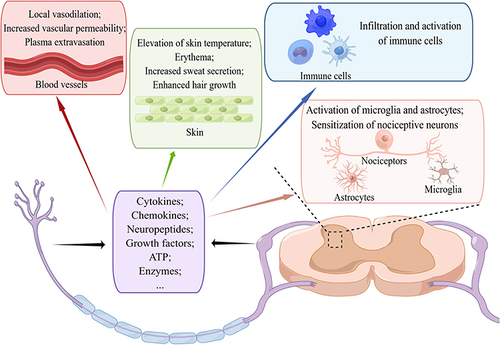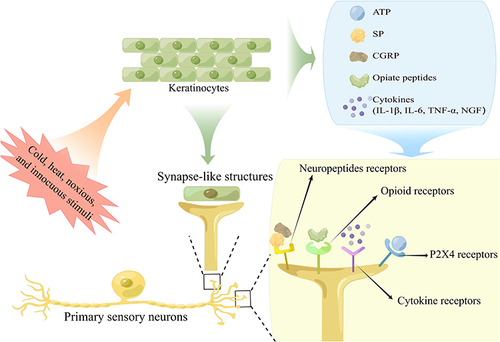Figures & data
Figure 1 The role of neurogenic inflammation in the pathophysiology of CRPS. Nociceptive receptors can be activated by mechanical or chemical stimulation, leading to the release of cytokines, chemokines, neuropeptides, growth factors, ATP and enzymes. In the peripheral nervous system, these substances can induce local vasodilation, increase vascular permeability and plasma extravasation, elevate skin temperature and cause erythema, enhance sweat secretion and hair growth, as well as infiltrate and activate immune cells; in the central nervous system, they are capable of sensitizing nociceptive neurons while activating microglia and astrocytes. (By Figdraw).

Figure 2 The role of cytokines and immune cells in the development of neuroinflammation in CRPS. Nociceptors release neuropeptides and neurotransmitters from their peripheral terminals, which activate immune responses. Immune cells infiltrate and produce numerous molecules that bind to receptors in nociceptors, leading to a shift towards a proinflammatory cytokine profile, ultimately resulting in an increase in neuronal excitability and sensitization. The bidirectional regulation and interaction between immune cells and neurons endow them with a crucial role in the pathogenesis of CRPS. (By Figdraw).

Figure 3 The role of keratinocytes in the development of neuroinflammation in CRPS. When exposed to various stimuli, such as cold, heat, and noxious and innocuous stimulation, keratinocytes can release ATP, SP, CGRP, IL-1β, IL-6, TNF-α and NGF to activate sensory nociceptors. Additionally, keratinocytes are capable of forming synapse-like structures to sensitize peripheral nociceptors. (By Figdraw).

